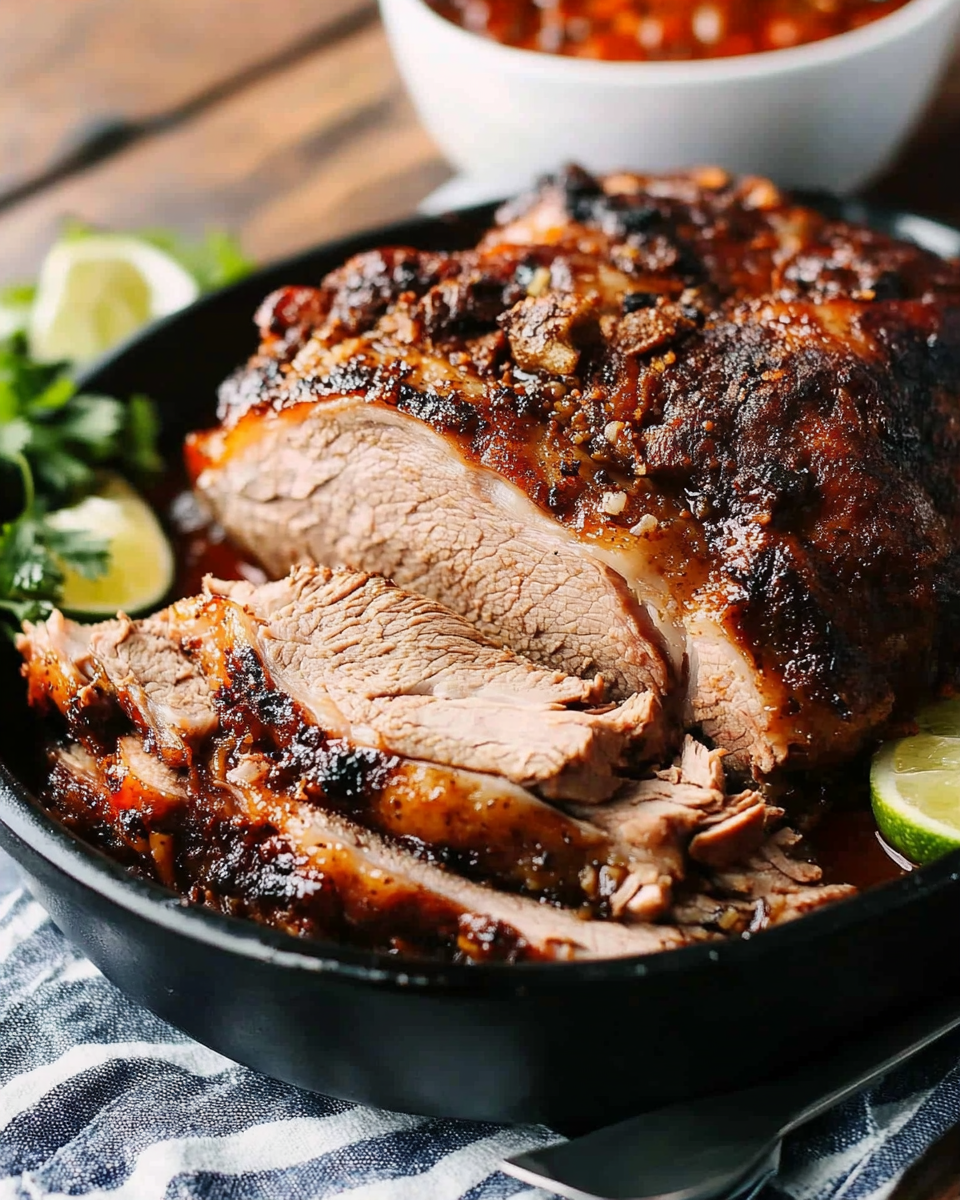The Origins of Pernil: A Traditional Puerto Rican Dish
Pernil has deep roots in Puerto Rican culture, where it is traditionally prepared during the holiday season as a part of festive meals. It has been passed down through generations, and while the method of preparation may vary slightly, the main elements—slow roasting and marinating—remain consistent. The dish is often served alongside classic Puerto Rican sides such as arroz con gandules (rice with pigeon peas), pasteles (similar to tamales), and a refreshing salad.
The name “Pernil” refers to a cut of pork, typically a shoulder or butt, that is marinated and roasted until perfectly tender. In many households, the marinated pork is cooked low and slow, allowing the meat to absorb the marinade’s flavors and develop its characteristic texture and taste. The crispy skin, in particular, is a highly coveted part of the dish and is often the star of the meal, offering a satisfying crunch to contrast with the juicy, tender meat beneath.
The Key Ingredients: Simple Yet Flavorful
What makes Pernil so delicious is the simplicity of its ingredients, which come together to create a harmonious blend of flavors. The marinade consists of garlic, olive oil, apple cider vinegar, lime juice, oregano, onion powder, cumin, chili powder, sugar, salt, and pepper. Each of these ingredients plays a crucial role in enhancing the flavor profile of the pork.
Garlic is a staple in Puerto Rican cooking and provides a savory, aromatic base for the marinade. Olive oil helps to bind the ingredients together and ensures the roast stays moist during cooking. Apple cider vinegar and lime juice add tanginess and brightness, balancing out the richness of the pork. The combination of dried oregano, onion powder, cumin, and chili powder adds depth and warmth to the dish, creating a savory and aromatic marinade that infuses the pork with incredible flavor.
The sugar in the marinade also plays an important role, balancing out the acidity of the vinegar and lime while contributing to the caramelization of the meat’s exterior, helping it achieve that coveted crispy crust. Whether you use a boneless roast or a skin-on roast, these ingredients work together to ensure that the Pernil is flavorful from the inside out.
Marinating the Pork: The Secret to Tenderness and Flavor
One of the most important steps in making Pernil is allowing the pork to marinate overnight. This process ensures that the pork absorbs all the wonderful flavors from the marinade, resulting in a roast that is flavorful and juicy. The dry rub is massaged into the pork, making sure every nook and cranny is coated, especially if you are using a skin-on roast. Scoring the skin in a crosshatch pattern before marinating allows the seasonings to penetrate deeper into the meat, ensuring an even flavor distribution.
Marinating the pork for at least 18 hours allows the spices to fully infuse the meat, and it’s during this time that the pork begins to tenderize. While the pork marinates, the flavor of the garlic, vinegar, lime juice, and spices penetrate deeply, ensuring that every bite is packed with taste. This step is essential for achieving the best results, so don’t rush it—let the meat marinate overnight for the best flavor and texture.
Slow-Roasting the Pernil: Low and Slow for Perfectly Tender Meat
The roasting process for Pernil is all about patience. The slow-roasting method allows the meat to cook evenly and retain its moisture, resulting in a roast that is incredibly tender and juicy. After searing the roast at high heat to develop a nice crust, the temperature is reduced to 350°F (170°C) for the majority of the cooking time.
The key to a perfect Pernil is ensuring that it’s cooked low and slow, which allows the connective tissue in the pork to break down and become tender. This slow cooking process also gives the pork time to absorb the flavors of the marinade, ensuring that every bite is bursting with flavor. As the roast cooks, you’ll want to add water to the roasting pan every 30 minutes to keep the meat moist and prevent it from drying out.
Once the roast reaches an internal temperature of 130°F for medium-rare or 140°F for medium, it’s time to remove it from the oven. The final step is allowing the roast to rest for about 15 minutes before slicing. Resting the meat helps to redistribute the juices, ensuring that the pork remains tender and juicy when sliced.
The Perfect Crispy Crust: Achieving that Delicious Texture
One of the most appealing aspects of Pernil is the crispy, flavorful crust. To achieve this, the roast is cooked at a high temperature for the first 30 minutes, allowing the exterior to become browned and crispy. After that, the oven temperature is reduced to finish cooking the roast slowly, ensuring the meat remains juicy on the inside while the crust becomes perfectly crispy.
The key to getting that delicious, crispy texture is to let the skin (if using a skin-on roast) develop a golden, crackling crust. The skin will crisp up beautifully during the roasting process, giving the dish its signature texture. For those who love the crispy skin, it’s often the most anticipated part of the dish, adding a satisfying crunch to each bite.
Serving Pernil: A Delicious and Festive Meal
Pernil is typically served with a variety of traditional Puerto Rican sides. Arroz con gandules, or rice with pigeon peas, is a classic accompaniment, as the flavors of the rice complement the rich, savory pork. A side of pasteles, a type of Puerto Rican tamale made from plantains and filled with meat or vegetables, also pairs wonderfully with Pernil. A fresh cucumber salad or a simple green salad adds brightness and crunch to balance the richness of the pork.
When serving Pernil, slice the roast into thick, juicy pieces, ensuring that each portion includes both tender meat and crispy skin. The onions from the roasting pan can be served alongside the meat, adding a sweet and savory flavor that complements the roast.
Conclusion: A Flavorful Tradition for Any Occasion
Pernil is a delicious and flavorful Puerto Rican dish that brings a taste of tradition to any occasion. Whether you’re preparing it for a special holiday gathering or a casual family dinner, this slow-roasted, marinated pork is sure to impress. The combination of tender, juicy meat and a crispy, flavorful crust makes Pernil a dish worth celebrating. With its simple ingredients and slow-cooked perfection, Pernil is not just a meal—it’s a delicious tradition that brings people together.

